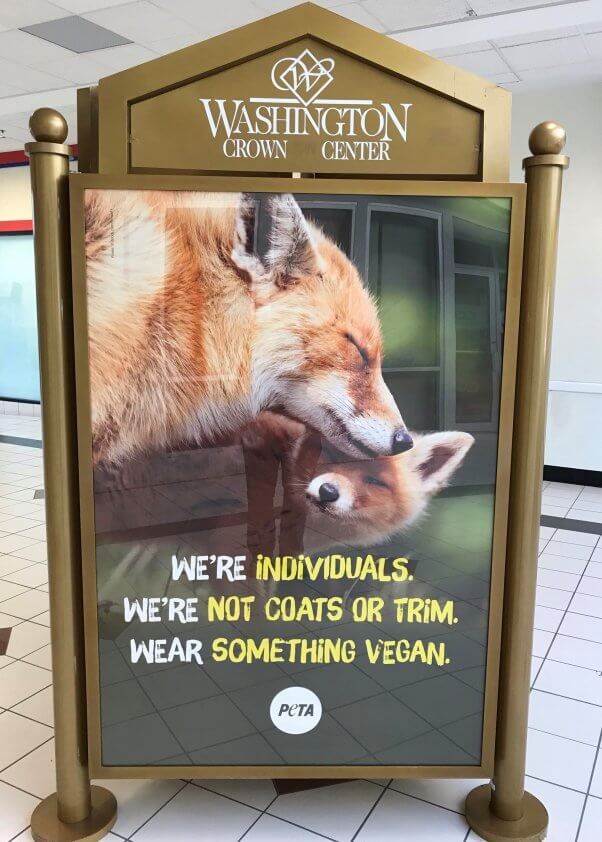Introduction
The biggest sarcasm in animal ethics is that even the people claiming to eat only vegan are often ignorant of the killings that must be made to make their leather apparel. Many animals are bred so that they can be big enough for slaughter. The lucrative fashion industry has often relied on fur, wool, horns, and feathers to make clothes and ornaments. However, it is unfortunate that in the animal kingdom, they hope for sudden and cruel death to meet the demands of people with other vegan options for making the desired clothes.
The Washington Mall Center advertisement post appeals to the public to have a change of mind (see appendix). The advertisement has an image of a mother and her baby with the caption, “We’re Individuals. We’re Not Coats or Trim. Wear Something Vegan” (Shircliff, 2018). The image and the words both appeal to its audience to reconsider their fashion choice. A combination of pathos, ethos, and logos is used to convince consumers to shop for vegan fashion. Although the vegan products remain contentious, the advertisement provides sufficient emotional, ethical, and logical appeal for individuals to vouch for a vegan fashion.
Rhetoric Analysis of the Ad
Pathos
Pathos appeal is when written, visual, or vocalized content evokes the audience’s emotion and convinces them to take a desired stance. The greater part of the advertisement consists of the image of the mother fox and the young one embracing their heads with closed eyes. The picture communicates love, relationship, care, and family. Humans are social beings, so they can relate to the image and the message it is communicating. The advert gives an impression of a caged fox because normally foxes are wild animals and would have been in the forest.
The emotional appeal is that the fox and its child are caged. Yet, they have not made any mistake worthy of the inhumane treatment that they are receiving. For example, humans would empathize with any incarcerated mother who is innocent yet separated from her children. The advert creates similar imagery making the audience sympathize with the mother fox because its fate is slaughter for fur while its young one remains lonely, awaiting cruel death once it matures. Thus, the picture of the family makes the audience see the happy relationship that the mother and child could have and the reality of the separation that awaits just so humans can have some clothes.
Ethos
The ethos appeals to ethics, morals, and personal integrity in making a decision. For example, in the image, the fox is caged against its will and will be slaughtered for fur. Moreover, the industrial effort used in producing animal products apparel damages the environment given that strong chemicals are used for preserving the fur to avoid rotting, and a lot of energy is needed for production (Choi & Lee, 2021). The caption stating that the animals are not coats and trims shows that the process of changing a living thing into a piece of clothing is long and immoral.
Ethics requires humans to always do what is right and make a fair decision. Yet, in the case presented by the advert, exchanging life for apparel involves pain and an end to life. The end outcome, which is getting clothing, does not justify the means, which is killing animals and polluting the environment. Thus, the advert appeals to the audience to uphold the virtues of value for life and conservation of the environment by choosing vegan fashion.
Logos
In addition, the advert employs logos, which appeals to facts and rational thoughts to convince the buyers to choose vegan. For example, one of the facts in the caption is that the foxes are not coats or trims. Moreover, the statement “we are individuals” is designed to appeal to the fact that animals are not exactly humans. Statistics indicate that making a single handbag requires killing three alligators (Choi & Lee, 2021, p.2). The implication is that animal apparel is more expensive than those made from plants.
Furthermore, the image used in the advertisement shows real animals who can feel and relate. For example, the mother and child are close and have a bond, as evident in how they show emotion when the heads embrace. The statement in the caption gives an option that people can buy vegan. Thus, the rationale is that people have an option when it comes to fashion. Furthermore, the vegan choice is cheaper and does not cause any suffering to the animals.
Conclusion
In conclusion, the advertisement is effective, with visuals and caption that appeals to emotions, ethics, and reason. The message evokes the feeling that the fox and its baby are a family destroyed by caging the mother and then killing it for clothes. The moral appeal is the pain the animals suffer, and the environmental pollution is unwarranted.
The facts of too many deaths are needed to make a handbag appeal to logic. The core message in the advertisement is that people have an option that is cheaper, environmentally friendly, and does not cost innocent lives. Thus, it successfully makes the audience reconsider their choice and vouch for vegan apparel.
References
Choi, Y., & Lee, K. (2021). Ethical consumers’ awareness of vegan materials: Focused on fake fur and fake leather. Sustainability, 13(1), 1-16. Web.
Shircliff, A. (2018). ‘Wear something vegan’ ad blitz hits local malls for the holidays. PETA. Web.
Appendix A
